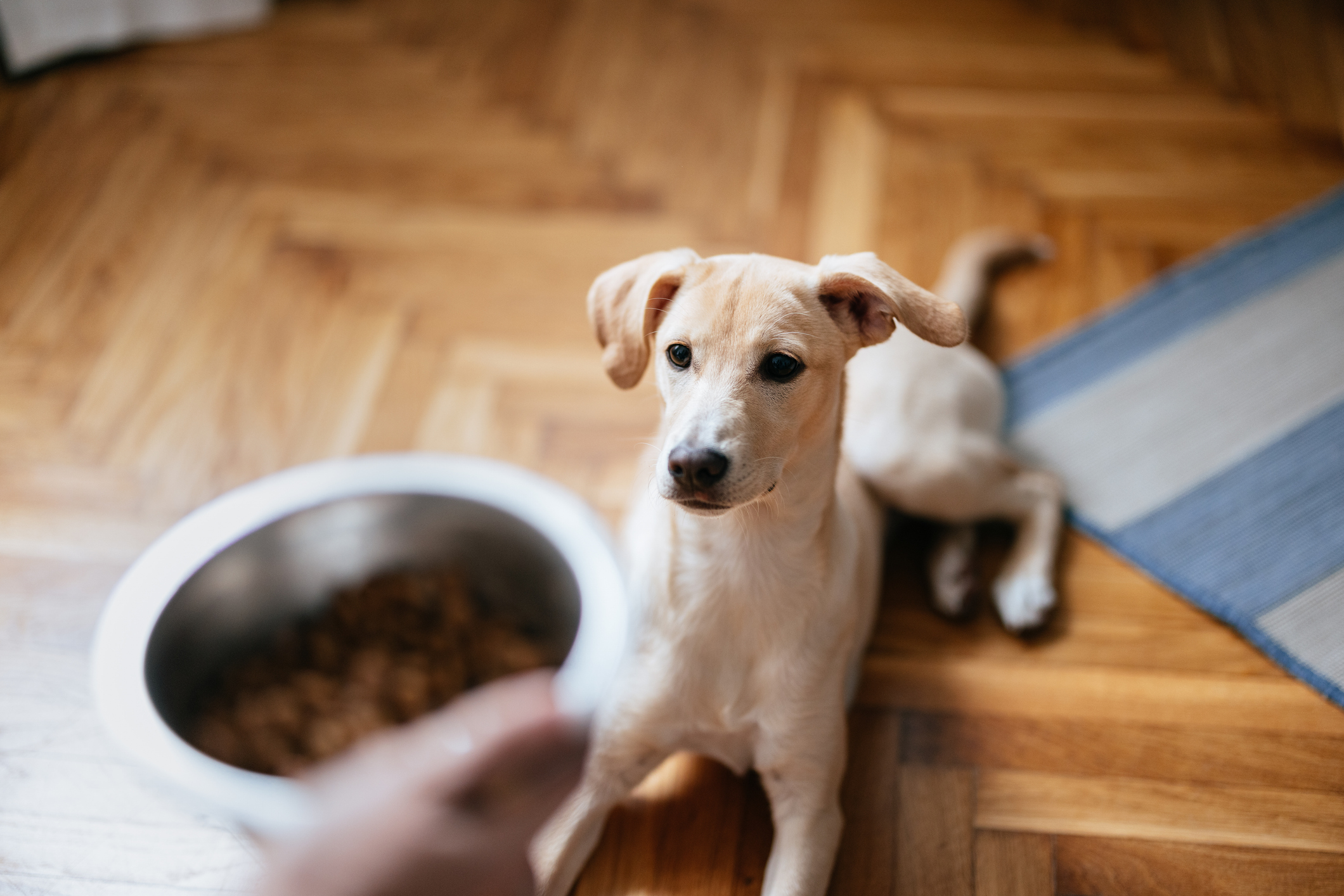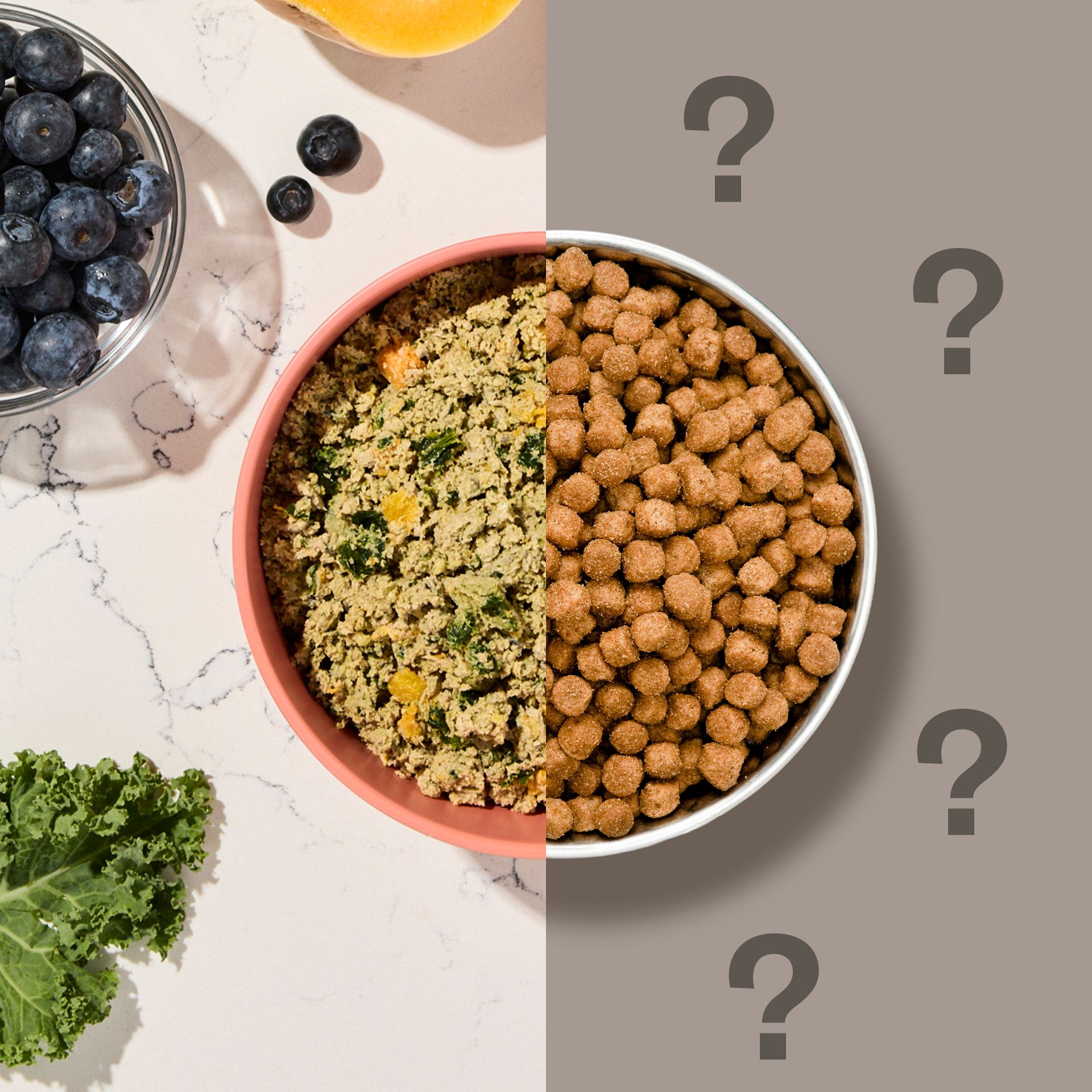Hey Ollie blog readers! We’re offering you an exclusive 60% OFF your starter box! Try now!
From their teeth to their tail tip, your dog’s digestive tract reflects their ancestral heritage as an omnivorous scavenger—consuming and absorbing nutrition with complete efficiency. On average, a dog takes between four to eight hours to digest their food—a fairly rapid process that multiple factors influence, which we’ll break down in this article. Explore canine digestion’s ins and outs, and discover how proper nutrition impacts all aspects of your dog’s wellbeing.
How Do Dogs Digest Food?
Despite massive variation between breeds, all dogs belong to the same species, and their gastrointestinal (GI) tracts’ parts and proportion are identical. According to an Innovative Veterinary Care Journal (IVC) article, the canine stomach plays a significant role in their digestive system, processing 70% percent of a dog’s ingesta (i.e., consumed food), while the small intestines (i.e., duodenum, ileum, and jejunum) and large intestines process the remaining 30%. In contrast, a person’s stomach performs only about 30% of the digestive process, while the intestinal tract manages the other 70% and most of the heavy lifting. These digestive system differences partially explain why humans eat several small meals throughout the day, chewing slowly, while dogs only eat once or twice a day, wolfing down their food with alarming speed!
Best Practices for Feeding Your Dog According to a Vet
Dogs’ Saliva Helps the Digestion Process
Contrary to popular belief, digestion begins in the mouth—not the stomach. Your dog’s saliva lubricates their food for easy passage, mixing with digestive enzymes that initiate the breakdown process. According to Dogster, pups also have superstrong esophageal muscles that forcibly push food down to a dog’s stomach, minimizing the need for thorough—and time-consuming—chewing.
Dogs’ Stomach Acid and Digestive Enzymes Break Down Food into Chyme
Once your dog’s meal arrives in their stomach, the digestive process really gets churning! The stomach is primed with extremely acidic fluid and powerful enzymes that aggressively break down food into chyme, a semiliquid substance.
At this point, the majority of the nutrients your dog needs have been isolated, and the remaining material is sent along to the intestine for the final goodbye. The canine intestinal tract is roughly three times as long as a dog’s body, and this body system’s main function is to remove water from the chyme and prepare it for departure as stool.

How Digestion Time Varies in Dogs
Although all dogs’ digestive organs and processes are the same, their digestive transit times can vary significantly based on factors such as a dog’s size, breed, age, and hydration and activity levels. Let’s take a closer look at each variable.
Your Dog’s Size Affects Their Digestion
Large- and giant-breed dogs’ digestion takes longer than that of small-breed dogs and puppies. According to Vetericyn, small dogs and puppies usually digest their food in about four hours, while larger breeds’ digestion can take as long as six to eight hours. This timing difference occurs because large-breed dogs eat larger meals, require more nutrients, and simply have a longer digestive tract through which the food must travel. A large-breed dog’s digestive tract also needs more time to absorb and circulate foods’ nutrients throughout their body.
Athletic Breeds Digest Foods More Quickly
Athletic and working breeds’ digestion process is speedier than that of companion or toy breeds because active dogs frequently perform duties or physical activities that are related to their breeds’ original purpose (e.g., hunting and tracking wild game, guarding livestock or property, or competing in canine sports). As a result, athletic and working breeds have inherited a quick metabolism. To be able to perform at their peak, these breeds are genetically inclined to have a robust stamina and recover rapidly after activity. Athletic breeds include:
- Border collie
- Labrador retriever
- German shepherd dog
- Belgian Malinois
- Greyhound
- Siberian husky
Age Can Slow Digestion in Dogs
Age is a significant and ever-changing factor in your dog’s digestion. As your puppy becomes a full-grown dog, their digestion time slows—which may result in unexpected weight gain. As the aging process continues, dogs’ metabolism progressively slows, leading to an increasingly longer digestion time.
While digestion times may change by only an hour or two, that’s a lot in dog years! For example, consider a young pup’s need for frequent bathroom breaks. You can do your part in optimizing your dog’s digestion by making sure they have the right food type for their breed, age range, and physical activity level.
Learn About the Best Foods for Your Dog’s Digestive Health!
Dehydration Slows Digestion in Dogs
Hydration is key to overall health. Dehydration slows digestion and weakens nutrient absorption throughout the body.
Ensure that your dog’s water bowl is always filled to the brim with fresh water, especially during the summer months and after a long walk or playdate in the park. High-moisture foods, such as Ollie’s fresh food recipes, are a convenient—and tasty—way to ensure your pup avoids becoming parched.
Active Dogs Enjoy Healthier Digestion
Regular physical activity promotes healthy digestion by improving gut motility and stool regularity. As such, active dogs—as opposed to sedentary pups—enjoy a much healthier and more efficient digestive process that maximizes their athletic potential and their nutrient absorption.
Depending on their exercise intensity and metabolism, active dogs may require additional protein or calories to maintain their body condition. Each dog has unique needs, so check with your veterinarian to ensure you’re giving your pup the right nutritional and exercise balance!
How Much Exercise Does My Dog Need?
Tips for Monitoring Your Dog’s Digestive Health
When you stick to the basic doggie health commandments your veterinarian recommended long ago, your pup should thrive. However, don’t hesitate to consult with your veterinarian if you suspect your dog has a digestive issue. Keep these tips in mind when monitoring your dog’s digestive health:
- Watch out for unusual eating behaviors such as hesitance to eat or slow eating.
- Ensure your pet remains hydrated by checking their gums for moisture.
- Track their bathroom trip frequency for poop regularity.
- Keep an eye on your dog’s stool quality and consistency.
- Avoid feeding your dog table scraps, however much they beg.
- Prevent your dog from licking/eating any weird stuff at the park.
What Your Dog’s Poop Says About Their Health
What if My Dog Cannot Digest Their Food?
Undigested or poorly digested food can have unpleasant consequences that, over time, can negatively impact your dogs’ health. An inappropriate diet or an internal issue that limits or blocks nutrient absorption may cause poor digestion. Dogs who are unable to digest their food may experience classic GI signs, including:
- Regurgitation
- Vomiting
- Stomach noises
- Flatulence (i.e., gas)
- Soft or loose stool, or frequent bowel movements
- Diarrhea
If your dog experiences digestive upset lasting longer than 24 hours, contact your veterinarian. They may recommend temporarily withholding food or feeding a bland diet until your dog’s GI inflammation subsides or they can diagnose and treat your pup’s condition.
Food Quality is Critical
All dog food is not created equal. In fact, extreme variations exist among dog food types, and how they affect your dog’s digestion and overall health. For example, foods with a high-moisture content—as opposed to dried bits and pellets—are almost always preferable for dogs. Moisture improves your dog’s hydration level, which has total-body health benefits, including:
- Enhanced digestive motility and function
- Increased nutrient and vitamin absorption
- Nourishment and support for vital organs, such as the kidneys, which are sensitive to dehydration
- Improved satisfaction (i.e., fullness) and slower eating speeds, which may aid weight loss
The greatest high-moisture content source is fresh whole foods. Of course, these ingredients alone aren’t enough to provide a proper canine diet. These foods must be carefully balanced and combined to ensure optimal nutrition without harmful excess or deficiency.
For such simple concepts, the reality of feeding your dog can be quite complex. As the IVC Journal states, each food component makes a difference—“moisture, processing, balance, structure, sourcing, amount, frequency of meals, and even how it is served.”
The solution: Our recipes are the real deal
Ollie makes feeding your dog the highest-quality food easier than ever before. No matter your dog’s age, breed, activity level, or allergy status, our plans are customized to suit their individual needs, and easy to modify if those needs change. Our mixed-bowl meal plans allow you to blend fresh and dry foods for maximum convenience, affordability, and paw-some palatability. Our fresh food recipes include:
- Beef with sweet potatoes and peas
- Chicken with rice and spinach
- Turkey with lentils and pumpkin
- Lamb with kale and butternut squash
Each veterinarian-formulated recipe is designed to optimize every aspect of your dog’s health.
Packed with omega-3 fatty acids for heart and brain health, protein for muscle maintenance, and fiber for digestion, each meal is perfectly balanced.
We also ensure that our recipes include no unnatural preservatives, and because we ship meals directly to your door, they’ll always be fresh, rather than collecting dust on the shelf.
No more guesswork, just the highest-quality ingredients for your dog’s best life.


Discover your dog’s personalized meal plan and get started today.
Get 50% off your first box of Ollie’s fresh
delivered meals!
The Ollie blog is devoted to helping pet parents lead healthier lives with their pups. If you want to learn more about our fresh, human-grade food, check out MyOllie.com.
Tagged As:

The nutrition your dog needs,
the food they want.

Enjoying our articles? Subscribe our Newsletters and get new articles directly to your inbox
You might also like
12 August 2025
5 MINS READ
Top 8 Allergens Hiding in Your Dog’s Bowl
As pup parents, we never want to see our dogs uncomfortable. When it comes to itching, swelling, and upset stomachs, the culprit may be in their bowl. Understanding the most common allergens and t…
by Ollie Pets
11 August 2025
5 MINS READ
Not all Processing Is Equal: What’s Really in Your Pet’s Bowl?
As pet parents, we know how important it is that our dogs live long, healthy, and happy lives. This is why at Ollie, we focus so much on what goes into their bowls. But did you know there may be s…
31 July 2025
4 MINS READ
The Healthiest US States for Dogs
The Ollie Health team, a team of veterinarians and veterinary technicians, reviews thousands of photos submitted through Ollie’s Health Screening service. That’s hundreds of dogs (and their st…
by Ollie Pets







